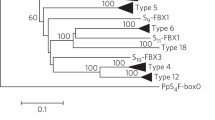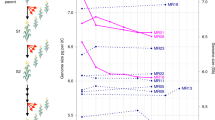Abstract
The self-incompatibility (S) gene in flowering plants has long been appreciated as an example of extreme allelic polymorphism maintained by frequency-dependent selection. Recent studies of population samples of S-allele sequences obtained by RT-PCR from five species of Solanaceae now reveal a picture of conspicuous inter-specific variation in both S-allele number and age. Explanations for this variation are examined with reference to current theory. We propose that changes in species' effective population size, particularly those associated with the evolution of different life histories, best account for interspecific differences in both the number and average age of S alleles.
Similar content being viewed by others
References
Anderson MA, McFadden GI, Bernatzky R, Atkinson A, Orpin T, Dedman H, Tregear G, Fernley R, Clarke AE: Sequence variability of three alleles of the self-incompatibility gene of Nicotiana alata. Plant Cell 1: 483–491 (1989).
Broothaerts W, Janssens GA, Proost P, Broekaert WF: cDNA cloning and molecular analysis of two self-incompatibility alleles from apple. Plant Mol Biol 27: 499–511 (1995).
Clark AG, Kao T-h: Excess nonsynonymous substitution at shared polymorphic sites among self-incompatibility alleles of Solanaceae. Proc Natl Acad Sci USA 88: 9823–9827 (1991).
Clarke AE, Newbigin E: Molecular aspects of selfincompatibility in flowering plants. Annu Rev Genet 27: 257–279 (1993).
Coleman CE, Kao T-h: The flanking regions of two Petunia inflata S-alleles are heterogeneous and contain repetitive sequences. Plant Mol Biol 18: 725–737 (1992).
Emerson S: A preliminary survey of the Oenothera organensis population. Evolution 24: 524–537 (1939).
Felsenstein J: PHYLIP (Phylogeny Inference Package). Distributed by the author. Department of Genetics, University of Washington, Seattle, WA (1996).
Franklin FCH, Franklin-Tong VE, Thorlby GJ, Howell EC, Atwal K, Lawrence MJ: Molecular basis of the incompatibility mechanism in Papaver rhoeas L. Plant Growth Regul 11: 5–12 (1992).
Hinata K, Watanabe M, Yamakawa S, Satta Y, Isogai A: Evolutionary aspects of the S-related genes of the Brassica selfincompatibility system: synonymous and nonsynonymous base substitutions. Genetics 140: 1099–1104 (1995).
Ioerger TR, Gohlke JR, Xu B, Kao T-h: Primary structural features of the self-incompatibility protein in Solanaceae. Sex Plant Reprod 4: 81–87 (1991).
Klein J, Satta Y, Takahata N, O'hUigin C: Trans-specific Mhc polymorphism and the origin of species in primates. J Med Primatol 22: 57–64 (1993).
Lawrence MJ, Lane MD, O'Donnell S, Franklin-Tong VE: The population genetics of the self-incompatibility polymorphism in Papaver rhoeas. V. Cross-classification of the Salleles of samples from three natural populations. Heredity 71: 581–590 (1993).
Lee HS, Huang SS, Kao T-H: S-proteins control rejection of self-incompatible pollen in Petunia inflata. Nature 367: 560–563 (1994).
Mantel N: Approaches to a health research occupancy problem. Biometrics 30: 355–362 (1974).
Matton DP, Maes O, Laublin G, Xike Q, Bertrand C, Morse D, Cappadocia M: Hypervariable domains of self-incompatibility RNases mediated allele-specific pollen recognition. Plant Cell 9: 1757–1766 (1997).
McClure BA, Haring V, Ebert PR, Anderson MA, Simpson RJ, Sakiyama F, Clarke AE: Style self-incompatibility gene products of Nicotiana alata are ribonucleases. Nature 21: 955–957 (1989).
O'Donnell S, Lane MD, Lawrence MJ: The population genetics of the self-incompatibility polymorphism in Papaver rhoeas.VI. Estimation of the overlap between the allelic complements of a pair of populations. Heredity 71: 591–595 (1993).
O'Donnell S, Lawrence MJ: The population genetics of the self-incompatibility polymorphism in Papaver rhoeas. IV. The estimation of the number of alleles in a population. Heredity 53: 495–507 (1984).
Olmstead RG, Sweere JA: Combining data in phylogenetic systematics: an empirical approach using three molecular data sets in the Solanaceae. Syst Biol 43: 467–481 (1994).
Parry S, Newbigin E, Craik D, Nakamura KT, Bacic A, Oxley D: Structural analysis and molecular model of a selfincompatibility RNase from wild tomato. Plant Physiol 116: 463–469 (1998).
Paxman GJ: The maximum likelihood estimation of the number of self-sterility alleles in a population. Genetics 48: 1029–1032 (1963).
Richman AD, Kao T-h, Schaeffer SW, Uyenoyama MK: Sallele sequence diversity in natural populations of Solanum carolinense Horsenettle. Heredity 75: 405–415 (1995).
Richman AD, Kohn JR: Learning from rejection: the evolutionary biology of single-locus incompatibility. Trends Ecol Evol 11: 497–502 (1996).
Richman AD, Kohn JR: Self-incompatibility alleles in Physalis: implications for historical inference from balanced polymorphisms. Proc Natl Acad Sci USA 96: 168–172 (1999).
Richman AD: S-allele diversity in Lycium andersonii: implications for inter-specific variation in S-allele age in the Solanaceae. Ann Bot (in press).
Richman AD, Kohn JR: Significant differences in S-allele diversification in taxa arising after a bottleneck event. Heredity (submitted).
Richman AD, Uyenoyama MK, Kohn J: S-allele diversity in a natural population of ground cherry Physalis crassifolia (Solanaceae) assessed by RT-PCR. Heredity 76: 497–505 (1996).
Richman AD, Uyenoyama MK, Kohn JR: Allelic diversity and gene genealogy at the self-incompatibility locus in the Solanaceae. Science 273: 1212–1216 (1996).
Saba-El-Leil MK, Rivard S, Morse D, Cappadocia M: The S11 and S13 self-incompatibility alleles in Solanum chacoense Bitt. are remarkably similar. Plant Mol Biol 24: 571–583 (1994).
Schierup M: The number of self-incompatibility alleles in a finite, subdivided population. Genetics 149: 1153–1162 (1998).
Singh A, Kao T-h: Gametophytic self-incompatibility: biochemical, molecular genetic, and evolutionary aspects. Int Rev Cytol 140: 449–483 (1992).
Swofford DL: Phylogenetic Analysis Using Parsimony (*and Other Methods). Sinauer Associates, Sunderland, MA (1998).
Takahata N: A simple genealogical structure of strongly balanced allelic lines and trans-species evolution of polymorphism. Proc Natl Acad Sci USA 87: 2419–2423 (1990).
Takahata N: Allelic genealogy and human evolution. Mol Biol Evol 10: 2–22 (1993).
Takahata N: Evolutionary genetics of human paleopopulations. In: Takahata, N, Clarke AG (eds), Mechanisms of Molecular Evolution, pp. 1–21. Sinauer Associates, Sunderland MA (1993).
Takahata N, Nei M: Allelic genealogy under overdominant and frequency-dependent selection and polymorphism of major histocompatibility complex loci. Genetics 124: 967–978 (1990).
Takezaki N, Rzhetsky A, Nei M: Phylogenetic test of themolecular clock and linearized trees. Mol Biol Evol 12: 823–833 (1995).
Thompson RD, Kirsch H-H: The S locus of flowering plants: when self-rejection is self-interest. Trends Genet 8: 381–387 (1992).
Uyenoyama MK: Genealogical structure among alleles regulating self-incompatibility in natural populations of flowering plants. Genetics 147: 1389–1400 (1997).
Vekemans X, Slatkin M: Gene and allelic genealogies at a gametophytic self-incompatibility locus. Genetics 137: 1157–1165 (1994).
Wright S: On the number of self-incompatibility alleles maintained in equilibrium by a given mutation rate in the population of a given size: a re-examination. Biometrics 16: 61–85 (1960).
Wright S: The distribution of self-incompatibility alleles in populations. Evolution 18: 609–619 (1965).
Wu J, Saupe SJ, Glass NL: Evidence for balancing selection operating at the het-c heterokaryon incompatibility locus in filamentous fungi. Proc Natl Acad Sci USA 95: 12398–12403 (1998).
Xue Y, Carpenter R, Dickinson HG, Coen ES: Origin of allelic diversity in Antirrhinum S locus RNases. Plant Cell 8: 805–814 (1996).
Yokoyama S, Hetherington LE: The expected number of selfincompatibility alleles in finite plant populations. Heredity 48: 299–303 (1982).
Author information
Authors and Affiliations
Rights and permissions
About this article
Cite this article
Richman, A.D., Kohn, J.R. Evolutionary genetics of self-incompatibility in the Solanaceae. Plant Mol Biol 42, 169–179 (2000). https://doi.org/10.1023/A:1006336206637
Issue Date:
DOI: https://doi.org/10.1023/A:1006336206637




